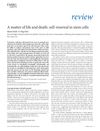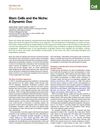Induction Of Tissue-Specific Premature Stem Cell Aging Promotes Senescence-Like Phenotypes In Remote Multiple Organs
November 2022
in “
Journal of Investigative Dermatology
”

TLDR Aging in one type of stem cell can cause aging-like changes in various organs.
The study reveals that the dysregulation of the DNA damage response (DDR) is a common molecular mechanism of stem cell (SC) aging. The researchers found that premature aging in intestinal stem cells (ISCs) promotes senescence-like phenotypes in multiple organs, including the skin. A transcription factor, which is commonly downregulated in aged mesenchymal stem/stromal cells (MSCs) and hematopoietic stem/progenitor cells (HSCs), was identified. The repression of this gene impairs DDR capacity. When this gene was deficient in ISCs, it not only induced loss of DDR capacity and inflammation in the aged intestine but also age-related dysfunctions in the brain, kidneys, and skin. Similarly, deficiency of the gene in epidermal stem cells (EpSCs) resulted in loss of DDR capacity, significant reduction of hair, accumulation of subcutaneous fat, and reduction of collagen, similar to aged skin. This suggests that this gene is crucial for the common molecular basis of SC aging.




